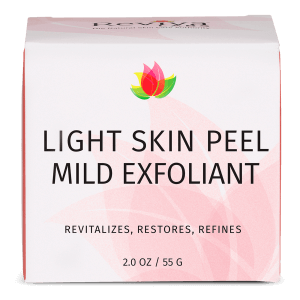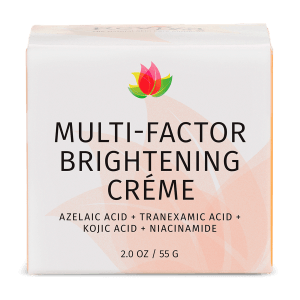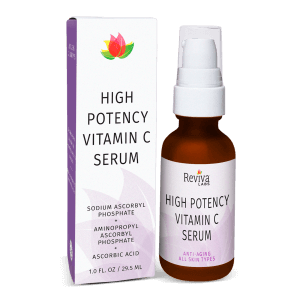Natural, Reviva Labs, Skin Care
What Causes Uneven Skin Tone & How To Treat It
Uneven skin tone, often manifesting as patches of discoloration, hyperpigmentation, or textural irregularities, is a common concern that affects the aesthetic harmony of the complexion. This phenomenon can be attributed to a variety of factors, both intrinsic and extrinsic, leading to an imbalance in the skin’s appearance. Delving into the causative factors is crucial for comprehending the underlying mechanisms and guiding effective treatment approaches.
One of the primary culprits of uneven skin tone is excessive sun exposure. Ultraviolet (UV) rays can trigger an overproduction of melanin, the pigment responsible for skin color, leading to sunspots or age spots predominantly in areas frequently exposed to the sun. Additionally, hormonal influences, particularly fluctuations associated with pregnancy, birth control pills, or hormone replacement therapy, can lead to melasma, a condition characterized by brown or gray-brown patches, predominantly on the face. Further complicating the picture, post-inflammatory hyperpigmentation (PIH) occurs following skin injury or inflammation, resulting in dark spots that emerge as the skin heals. Factors such as acne, eczema, or even certain skincare treatments can precipitate this response.
The Role of Intrinsic Factors
Intrinsic factors also play a significant role in skin tone irregularities. Genetics dictate our skin’s baseline color and texture, and they also influence how our skin responds to external stressors. As we age, the natural lifecycle of skin cells slows down, leading to an accumulation of pigmented cells in certain areas, which can significantly contribute to an uneven complexion. Furthermore, certain medical conditions and medications can lead to skin discoloration, making a comprehensive health assessment an integral part of addressing skin tone concerns.
Navigating Through Treatment Options
When it comes to addressing uneven skin tone, the spectrum of treatment options is as diverse as the causes. The cornerstone of any treatment regimen is sun protection. Consistent use of broad-spectrum sunscreens with an SPF of 30 or higher is critical in preventing further sun damage and in mitigating the risk of exacerbating existing pigmentation issues. Sun protection is not only about using sunscreen; it also involves wearing protective clothing and seeking shade during peak sun hours.
In addition to sun protection, there are various topical treatments aimed at lightening hyperpigmentation. Ingredients such as vitamin C, licorice extract, and kojic acid are known for their brightening properties. These agents work by inhibiting the enzyme tyrosinase, which is crucial in the production of melanin. Retinoids, derivatives of vitamin A, are also effective in treating uneven skin tone. They accelerate cell turnover, promoting the shedding of pigmented cells, and pave the way for the emergence of new, unblemished skin. It’s important to note that while these ingredients can be highly effective, they must be introduced into skincare routines gradually and under the guidance of a skincare professional to prevent irritation and ensure compatibility with individual skin types.
Embracing a Holistic Approach
While topical treatments are fundamental in addressing uneven skin tone, a holistic approach, encompassing lifestyle modifications and professional treatments, can provide more comprehensive results. Dietary changes that include a rich intake of antioxidants and anti-inflammatory foods can support skin health from the inside, combating oxidative stress and inflammation, which are known contributors to skin discoloration. Staying hydrated and maintaining a balanced diet can also reflect positively on the skin’s appearance.
For those seeking more immediate or dramatic results, professional treatments such as chemical peels, laser therapy, or microdermabrasion may be worth considering. Chemical peels involve the application of a chemical solution to the skin, which exfoliates the top layers and reveals fresher, more evenly pigmented skin beneath. Laser therapy targets specific pigments in the skin, breaking them down and allowing the body to remove them naturally. Microdermabrasion is a mechanical exfoliation technique that gently removes the uppermost layer of dead skin cells, promoting cell renewal and pigment dispersion. These treatments, often more potent and rapid in their effects, should be conducted by qualified professionals and tailored to individual skin types and concerns.
Journey to Radiant, Even-Toned Skin
Uneven skin tone, a multifaceted concern rooted in a complex interplay of factors, can be a source of frustration for many. However, understanding its causes paves the way for targeted and effective solutions. From diligent sun protection and strategic topical treatments to embracing a holistic lifestyle and considering professional interventions, the pathway to achieving a radiant, even-toned complexion is within reach. As with any skincare journey, patience, consistency, and a tailored approach are key. It’s also essential to consult with skincare professionals to devise a regimen that aligns with individual needs and skin types, ensuring that the journey to radiant, even-toned skin is not only successful but also safe and enjoyable.
Causes of Uneven Skin Tone Quick Video Summary













